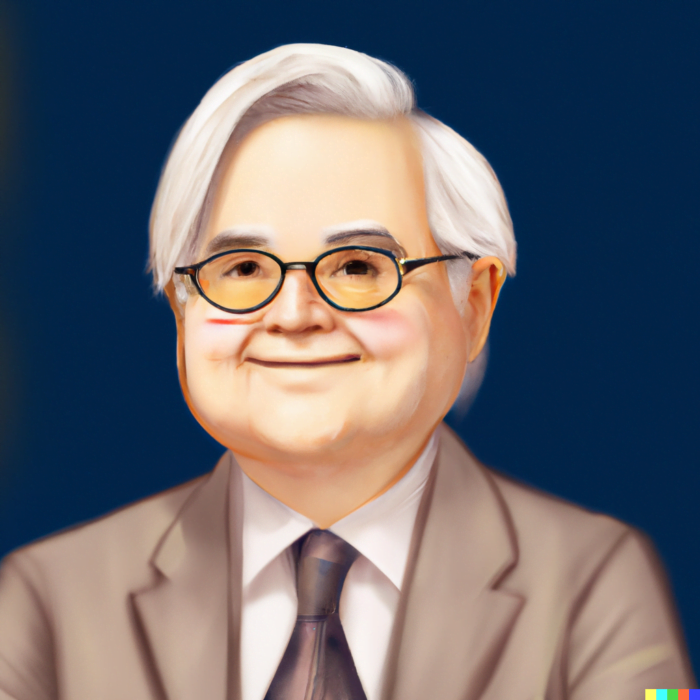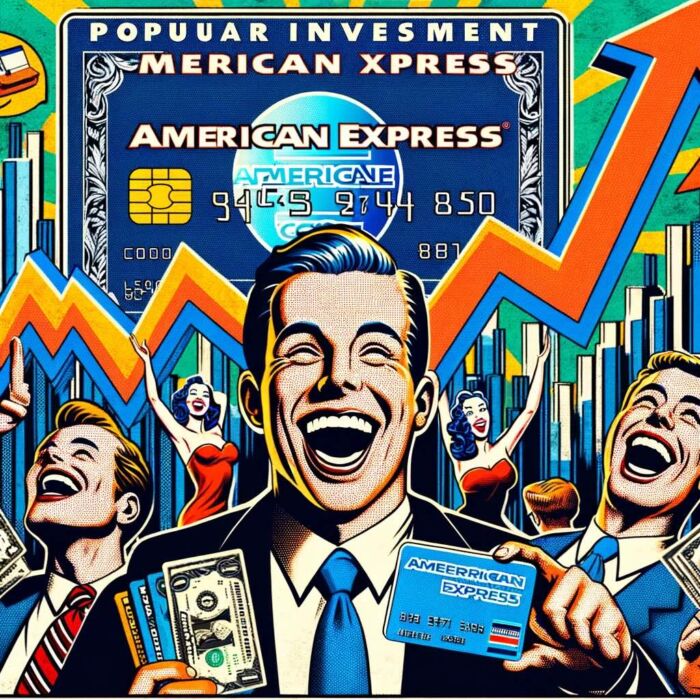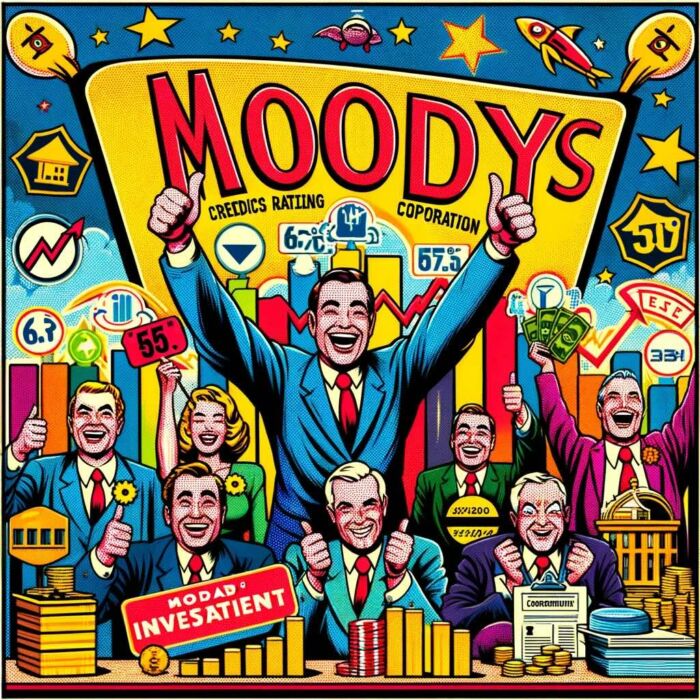Warren Edward Buffett, affectionately known as the “Oracle of Omaha”, has solidified his place in the annals of financial history as one of the most successful investors of all time. Born in 1930 in Omaha, Nebraska, he showcased an early proclivity for business, making his first stock purchase at the tender age of eleven. Today, Buffett’s personal net worth hovers around the $100 billion mark, a testament to his investing prowess and decades of disciplined approach to the stock market.

At the heart of Buffett’s success lies Berkshire Hathaway, a multinational conglomerate holding company that he began aggressively buying shares in during the 1960s. Under Buffett’s leadership, Berkshire Hathaway morphed from a struggling textile manufacturing company to an investment powerhouse, with a vast portfolio that covers everything from insurance and utilities to rail transportation, manufacturing, and retail. What’s fascinating is that this transformation was not a product of chance, but a reflection of a meticulously crafted investment approach.

Berkshire Hathaway’s investment approach, often described as a paragon of ‘value investing’, is guided by a few fundamental principles. It involves buying shares in businesses viewed as undervalued but boasting solid fundamentals, a robust business model, and promising long-term prospects. Key to this is the notion of investing in companies, not just stocks. Buffett famously opined, “It’s far better to buy a wonderful company at a fair price than a fair company at a wonderful price.”
In the article that follows, we delve deeper into the intricate workings of the Buffett investment machine. We’ll walk through his top 10 stock picks, shedding light on why these particular companies made it into his portfolio, and what each choice tells us about his broader investment philosophy. We’ll also extract key lessons from these investments and explore practical steps to apply these nuggets of wisdom to our own portfolios. So, buckle up and prepare for an exhilarating journey into the mind of one of the greatest investors of our time.

Warren Buffett’s Investment Philosophy
To step into the world of Warren Buffett’s investing is to enter a realm where simplicity trumps complexity, patience overpowers immediate gratification, and long-term value reigns supreme over short-term speculation. Warren Buffett’s investing philosophy, steeped in the principles of value investing, reflects an unerring belief in the power of the market to correct itself, and a unique ability to spot value where others see none.
The bedrock of this philosophy is grounded in the teachings of Benjamin Graham, Buffett’s professor at Columbia University and the father of value investing. Graham, in his seminal works, “Security Analysis” and “The Intelligent Investor”, expounded the philosophy that an investor should approach the stock market as a ‘business owner’, rather than as a ‘speculator’. Buffett, a keen disciple of Graham, took these lessons to heart, applying them with a level of consistency and discipline that would become his trademark.
At its core, Buffett’s philosophy of value investing involves buying shares in companies that are trading for less than their intrinsic value. The keyword here is ‘intrinsic value’, a concept that refers to an estimation of the cash that can be taken out of a business during its remaining life. In simpler terms, it’s the actual worth of a company, not just its current market price.

All About Intrinsic Value
The calculation of intrinsic value is not an exact science, and Buffett often likens it to trying to hit a bird with a slingshot in the dark. But it’s in the pursuit of this elusive figure that Buffett’s mastery truly shines. He has a knack for identifying businesses with durable competitive advantages—what he calls ‘economic moats’—like strong brands, cost advantages, or regulatory protections that help to safeguard their long-term profits and market share.
However, value investing isn’t just about picking stocks trading below their intrinsic value. It’s also about having the patience to wait for the market to recognize the true value of these stocks. As Buffett once noted, “The stock market is a device for transferring money from the impatient to the patient.” This underscores another key tenet of his philosophy: a long-term investment horizon.
In a world increasingly characterized by high-speed trading and short-term speculation, Buffett’s investment philosophy might seem almost antiquated. Yet, it is precisely this enduring, timeless quality that makes it so effective. In the frenzied cacophony of the market, Buffett’s philosophy serves as a guiding light, illuminating a path characterized by disciplined investing, patient waiting, and unyielding faith in the power of business value. It’s a philosophy not just for investing in the stock market, but for making sense of it.
source: Investor Center on YouTube
Warren Buffett’s Top 10 Stock Picks
Navigating the financial ocean teeming with stocks can be daunting for many. The countless options, the erratic market behavior, the fear of the unknown – it’s a whirlpool that often leaves us feeling lost and overwhelmed. But, as the saying goes, “A smooth sea never made a skilled sailor.” To weather this storm, it helps to take a leaf out of Warren Buffett’s book, to learn from his skillful sailing across this financial sea. In this section, we’ll do just that as we unveil Warren Buffett’s top 10 stock picks.
These stock picks aren’t drawn from the rumors that float around in the financial corners of the internet or the gossip mills of Wall Street. Instead, they’re gleaned from the most credible sources one can get: U.S. Securities and Exchange Commission (SEC) filings and Berkshire Hathaway’s annual shareholder letters. In these documents, Berkshire Hathaway dutifully discloses the state of its vast portfolio to the public. It’s from these disclosures that we’ve culled our information, ensuring the authenticity and reliability of our list.
Before we delve into the list, let’s take a moment to understand its significance. This isn’t just a rundown of companies in which Buffett has invested. Each stock pick is a testament to his investment philosophy, his deep faith in value investing, and his unique understanding of the market. These aren’t companies chosen at random; each is a carefully selected piece of the larger Berkshire Hathaway portfolio puzzle, picked for its potential to add value over the long term.
These stock picks also serve as a learning ground for us. They reveal the traits that Buffett values in a business, whether it’s a strong economic moat, a robust business model, or a capable management team. By examining these picks, we can not only understand Buffett’s investment strategy better but also glean valuable insights for our own investment decisions.
So, without further ado, let’s set sail on our journey through the sea of Buffett’s top 10 stock picks. Along the way, we’ll learn about each company, why it made the cut, and what it tells us about the broader investment approach of the Oracle of Omaha. Hold tight, for the sea might get choppy, but remember: every wave, every surge is a lesson in becoming a better investor.
source: CNBC Television on YouTube
Stock Pick #1: Apple Inc.
Apple Inc., the tech behemoth that needs no introduction. Steeped in innovation and driven by a relentless pursuit of excellence, Apple has etched its name into the annals of technological history as one of the most valuable and influential companies in the world. Known for its suite of products that have become almost synonymous with modern life – the iPhone, iPad, Mac, and more recently, services like Apple Music and iCloud – Apple has a knack for creating devices that aren’t just products, but a lifestyle.

So, why did the Oracle of Omaha, a man known for his love of undervalued, often unglamorous companies, put his money into this flashy tech titan? The answer lies in Apple’s incredibly strong ‘economic moat’, a term Buffett uses to describe a company’s competitive advantage. Apple’s brand strength, its ecosystem of products and services that keep customers within its fold, and its massive, loyal consumer base all contribute to a moat that is as wide as it is deep.
Buffett, a self-confessed technophobe, has often steered clear of tech stocks, citing his lack of understanding of the tech sector. But with Apple, he made an exception. In a CNBC interview, he admitted that he sees Apple more as a consumer goods company, rather than a tech company. He was impressed by Apple’s ability to create consumer-oriented products and admired the company’s ecosystem that practically guaranteed repeated business.
Looking at the performance of Apple stock, it’s evident that Buffett’s bet paid off handsomely. Since Berkshire Hathaway’s first investment in Apple back in 2016, the stock has seen substantial growth. And while the road has not been devoid of bumps – take, for example, the impact of U.S.-China trade tensions or the global chip shortage – Apple’s resilient business model and its ability to consistently deliver strong financial results have seen it through.
Investing in Apple wasn’t just a financial decision for Buffett; it was a testament to his investment philosophy. Apple, with its wide moat, its focus on the consumer, and its strong business model, ticked all the boxes for a typical Buffett investment. The tech titan’s performance in the stock market was just the cherry on top of a well-baked Buffett pie.
In the grand tapestry of Berkshire Hathaway’s investment portfolio, Apple is a vibrant thread, a symbol of the flexibility inherent in Buffett’s investment approach. It serves as a reminder that while certain sectors may seem out of our understanding or comfort zone, there are still potential opportunities if we shift our perspective and dare to venture into unfamiliar territory.
source: The Coca-Cola Co. on YouTube
Stock Pick #2: The Coca-Cola Company
The Coca-Cola Company, a name that conjures images of crisp red cans, swirling ribbons of white, and a taste that is recognized in every corner of the globe. The iconic beverage company has been quenching the world’s thirst with its eponymous soda since 1886, and today, its product portfolio has expanded to include a diverse range of beverages, from juices and teas to bottled water and energy drinks.
Buffett’s romance with Coca-Cola started not in the boardroom, but in the soda fountain. As a six-year-old, he bought his first six-pack of Coke for a quarter and sold each can for five cents, making a neat 20% profit. Years later, he would bring his childhood love for Coke to Berkshire Hathaway’s investment portfolio, but not for sentimental reasons.

Buffett invested in Coca-Cola in 1988, a time when the company was emerging from a period of criticism over its ‘New Coke’ fiasco. Buffett saw past the temporary troubles. He saw a company with a powerful brand, a product that people loved, and a wide global footprint. He recognized that Coca-Cola’s brand was its moat, protecting it from competitors and ensuring customer loyalty.
But it wasn’t just the brand. It was also the company’s resilient business model, characterized by strong cash flows and consistent dividend payments, a surefire recipe for long-term value. “A ham sandwich could run Coca-Cola,” Buffett has famously said, emphasizing the strength and simplicity of its business model.
Since the initial investment, Coca-Cola’s performance has been nothing short of remarkable. Despite the inevitable ups and downs, the stock’s general trajectory has been upward, delivering substantial returns to Berkshire Hathaway. Even more impressive are the dividends that Coca-Cola has paid over the years, a stream of income that Buffett refers to as his favorite holding period – “forever.”
Coca-Cola is a classic example of Buffett’s love for companies with ‘economic moats’. It’s a reminder that a strong brand can be a powerful protective barrier, and that in the world of investing, often, simplicity trumps complexity. Coca-Cola, with its iconic brand and straightforward business model, remains a sparkling example of Buffett’s investment philosophy, a testament to the wisdom of investing in businesses you understand and believe in.
source: The Long-Term Investor on YouTube
Stock Pick #3: American Express
American Express, fondly known as AmEx, is a multinational financial services corporation, best recognized for its range of credit cards, charge cards, and traveler’s cheque businesses. Founded in 1850 as an express mail business, AmEx has weathered the financial storm of over a century to emerge as one of the top players in the world of finance.
The story of how American Express made it into Berkshire Hathaway’s portfolio is a bit like an adventure film – it involved a crisis, a keen eye for opportunity, and a bold step towards the future. In 1963, American Express was embroiled in the ‘Salad Oil Scandal’, a financial fiasco that shook investor confidence and sent the company’s stock price tumbling. This was when Buffett swooped in.

Recognizing that the core business of American Express remained sound despite the scandal, Buffett saw a classic case of a strong company temporarily undervalued by market panic. Moreover, he acknowledged that American Express had a unique competitive advantage in the financial industry: its powerful brand and a trusted reputation that commanded customer loyalty.
The investment turned out to be a masterstroke. American Express not only survived the Salad Oil Scandal, but it also grew from strength to strength, expanding its customer base and diversifying its offerings. As for the performance of the stock, it has seen a significant appreciation over the years, proving that Buffett’s faith in the company was well-founded.
American Express is a shining illustration of Buffett’s knack for distinguishing between a company’s temporary problems and its long-term value. The investment underscores one of the key principles of his philosophy: don’t be swayed by short-term market hysteria; instead, focus on the fundamental strength of a business. The strong performance of American Express in the decades following Buffett’s investment serves as a beacon for investors, illuminating the path of value investing amidst the often murky waters of the financial markets.
source: David Rubenstein on YouTube
Stock Pick #4: Bank of America
Bank of America, the second-largest banking institution in the United States, is known for its vast array of financial services spanning banking, investing, asset management, and other financial and risk management products and services. It is a household name, and for many Americans, the face of everyday banking.
In 2011, in the aftermath of the financial crisis, Bank of America was struggling, and the banking sector was facing deep skepticism. Amid this upheaval, Berkshire Hathaway stepped in, investing $5 billion in Bank of America preferred stock, an investment that came with warrants to buy 700 million shares at a strike price of around $7.14 per share.

So, why did Buffett invest in a bank in the midst of a financial crisis? The answer lies in his ability to see through the fog of the present to the clarity of the future. Buffett recognized that despite the challenges it faced, Bank of America was a fundamentally strong institution. He believed in its potential to recover, to stand tall amid the ruins, and to become stronger in the wake of the crisis.
And he was right. Bank of America has not only recovered from the financial crisis but also grown considerably, becoming more profitable and returning more capital to shareholders in the form of dividends and share buybacks. The performance of the stock reflects this growth, offering substantial returns on Berkshire Hathaway’s initial investment.
Bank of America is a sterling example of Buffett’s value investing strategy in action. It underscores his courage to swim against the tide, to spot value when others see ruin, and to remain steadfast in his belief in the power of strong fundamentals. The investment in Bank of America is more than just a smart financial move—it’s a testament to the power of belief, the virtue of patience, and the rewards of resilience.
source: IDP on YouTube
Stock Pick #5: Moody’s Corporation
Moody’s Corporation, a business services company, is known for its role as a credit rating agency. Its core asset, Moody’s Investor Service, is a trusted and widely recognized provider of credit ratings, research, and risk analysis. These ratings play a critical role in the global financial system, shaping investment decisions and influencing the cost of capital for companies around the world.
Berkshire Hathaway’s investment in Moody’s can be traced back to 2000 when it acquired an interest through a corporate spin-off. Buffett, appreciating the nature of Moody’s business model, chose to keep and increase the stake.

Moody’s operates in an industry with high barriers to entry, given the regulatory scrutiny and the reputational trust required. This provides a strong ‘economic moat’. Furthermore, it has a scalable business model, as the cost of rating an additional bond is marginal, allowing for substantial operating leverage.
Another key feature that likely caught Buffett’s eye is the company’s ability to generate substantial free cash flows due to its low capital expenditure requirements. This is a common trait that Buffett looks for in his investments as it provides more capital that can be distributed back to shareholders or reinvested into growing the business.
The performance of Moody’s stock over the years has been overwhelmingly positive. Despite the occasional market downturns and regulatory scrutiny, Moody’s has proven to be a resilient player, consistently growing its revenue and earnings.
The Moody’s investment is a masterclass in understanding the power of economic moats and the value of free cash flow generation. It shows how looking beyond the glamour of a business to its core fundamentals can uncover opportunities that others might overlook. In the grand architecture of Buffett’s portfolio, Moody’s stands as a testament to the durability of his investment philosophy and the wisdom of his choices.
source: Yahoo Finance on YouTube
Stock Pick #6: Dairy Queen
Dairy Queen, with its iconic soft-serve ice cream and an array of fast-food items, is a name that brings a smile to the faces of millions across the globe. Founded in 1940, Dairy Queen has become a fixture in the world of casual dining and quick-service restaurants.
The tale of Berkshire Hathaway’s acquisition of Dairy Queen in 1998 is one steeped in the fundamentals of Buffett’s investment philosophy. The Oracle of Omaha has always been vocal about his love for simple, easy-to-understand businesses, and Dairy Queen fits this description to a tee. It’s a straightforward business model: provide delicious food and treats at a reasonable price in a clean and inviting environment.

Another compelling reason for the acquisition was Dairy Queen’s strong brand presence and customer loyalty. These intangible assets formed a robust ‘economic moat’ that helped it fend off competition, an essential attribute that Buffett often seeks in his investments.
The performance of Dairy Queen under Berkshire Hathaway’s ownership has been impressive. Despite operating in a highly competitive industry, Dairy Queen has maintained steady growth, expanded globally, and consistently added value to Berkshire Hathaway’s portfolio.
Investing in Dairy Queen wasn’t a matter of simply buying shares in a company; it was about acquiring a business that embodied the principles Buffett cherished: simplicity, strong brand value, and customer loyalty. Dairy Queen’s continued success is a testament to the effectiveness of Buffett’s approach. It serves as a delicious reminder that in investing, as in ice cream, sticking to the basics can often yield the sweetest rewards.
source: CNBC Television on YouTube
Stock Pick #7: Kraft Heinz
Kraft Heinz is a multinational food and beverage company known for its iconic brands such as Heinz Ketchup, Kraft Macaroni & Cheese, Oscar Mayer, and Philadelphia Cream Cheese, to name just a few. These are brands deeply woven into the fabric of everyday life in countless households.
The story of Berkshire Hathaway’s investment in Kraft Heinz is a bit unconventional in the context of Buffett’s typical investing style. In 2015, in partnership with 3G Capital, Buffett helped orchestrate the merger of Kraft Foods Group and H.J. Heinz Company, creating one of the largest food and beverage companies in the world.

Buffett was likely attracted to both Kraft and Heinz due to their strong, recognizable brands and their robust cash flows. These companies’ products had a consistent demand, making their revenues relatively stable and predictable. Moreover, the opportunity to unlock significant cost savings through the merger likely added to the investment’s appeal.
However, the performance of Kraft Heinz post-merger has not lived up to expectations. The company has struggled with changing consumer preferences toward healthier and organic food options, leading to stagnant growth. The stock has underperformed since the merger, leading Buffett to admit in 2020 that he overpaid for the investment.
The Kraft Heinz investment offers some important lessons. It serves as a reminder that even the most seasoned investors like Buffett can misjudge an investment. It also underscores the need for companies to stay adaptable and responsive to changing market dynamics. Nevertheless, despite the underperformance, Buffett has chosen to hold onto Kraft Heinz, expressing confidence in its stable of reliable, well-known brands and its potential for turnaround.
source: Yahoo Finance on YouTube
Stock Pick #8: Verizon Communications Inc.
Verizon Communications, one of the largest telecommunications companies in the world, offers wireless communications, internet access, and media and entertainment products and services. Founded in 1983 and headquartered in New York, it has established a substantial presence across the globe.
The story of Berkshire Hathaway’s investment in Verizon begins in 2020 when Buffett significantly increased his stake in the telecommunications giant. The investment can be seen as a testament to Buffett’s faith in the long-term value of reliable, high-dividend-yielding stocks in an era of technological advancements.

Buffett was likely attracted to Verizon for several reasons. First, Verizon operates in an industry with high barriers to entry due to regulatory hurdles and the massive infrastructure required, which limits competition and protects the company’s profits. Second, Verizon’s strong cash flow generation, fueled by a large and stable customer base, is ideal for Buffett’s investment style. Finally, its attractive dividend yield adds to the overall appeal, given Buffett’s fondness for income-generating investments.
Verizon’s performance in recent years has been marked by steady revenue growth and a strong dividend track record. While it may not have provided explosive growth like some tech stocks, it has offered stability and consistent returns, attributes that align well with Buffett’s investment philosophy.
Investing in Verizon underscores Buffett’s approach of preferring businesses with durable competitive advantages and strong cash flows. It’s a reminder that the latest or most glamorous industries aren’t always the best investment. Sometimes, the most rewarding investments are those that provide essential services, day in and day out, quietly generating value for their shareholders.
source: CNBC Television on YouTube
Stock Pick #9: Chevron Corporation
Chevron Corporation is one of the world’s leading integrated energy companies, involved in virtually every aspect of the energy sector, from oil and gas exploration and production to refining and marketing. Headquartered in San Ramon, California, it operates in more than 180 countries.
Berkshire Hathaway’s decision to invest in Chevron, announced in 2020, reflects Buffett’s belief in the long-term prospects of the energy sector, despite the industry’s volatility. While renewable energy is increasingly important, oil and gas are likely to remain significant components of the energy mix for the foreseeable future.

Buffett has historically favored businesses that generate substantial cash flows and offer a competitive ‘moat’ or advantage. Chevron fits this profile. As one of the largest oil companies globally, it has a scale and breadth of operations that few can match. Its diversified operations, covering upstream (exploration and production) and downstream (refining, marketing, and transport) activities, also help mitigate risks associated with fluctuations in oil prices.
In terms of stock performance, Chevron has seen ups and downs reflecting the cyclical nature of the oil and gas industry. However, it has been a consistent dividend payer, making it attractive to income-focused investors like Buffett.
The Chevron investment reflects Buffett’s willingness to invest in sectors that others may overlook due to short-term challenges. It is a reminder that long-term investing requires a vision that sees beyond temporary market trends to the enduring value that solid, well-managed companies can offer.
source: Buffett Online on YouTube
Stock Pick #10: BYD Company
BYD Company is a Chinese manufacturer of automobiles, battery-powered bicycles, buses, forklifts, solar panels, rechargeable batteries, and most notably, electric cars. Founded in 1995 as a battery manufacturer, it has grown into a major player in the global electric vehicle industry.
Buffett’s investment in BYD back in 2008 was quite an unusual move, considering his renowned aversion to high-tech and foreign stocks. Berkshire Hathaway’s subsidiary, MidAmerican Energy, acquired a 9.9% stake in BYD, marking one of Buffett’s earliest bets on clean energy and electric vehicles.

Buffett was persuaded to invest in BYD by his longtime business partner, Charlie Munger, who was impressed by the company’s founder and his vision for the future of transportation. Indeed, it was BYD’s leadership, potential for growth in the electric vehicle market, and its integration of battery production and automobile manufacturing that made it a compelling investment.
Since Berkshire Hathaway’s investment, BYD’s performance has seen remarkable growth. The company has expanded its footprint in the global electric vehicle market, even amid intense competition. BYD’s share price has also appreciated significantly, making it one of the most successful investments in Buffett’s portfolio.
The BYD investment showcases Buffett’s flexibility as an investor. While he is known for his conservative, value-oriented approach, he is not afraid to venture into new territories when he sees exceptional potential. It emphasizes that while sticking to one’s investment principles is important, the ability to adapt and seize novel opportunities can lead to substantial rewards.

Key Lessons From Warren Buffett’s Stock Picks
Diversification
From consumer goods to tech companies, from insurance to energy sectors, Warren Buffett’s top ten stock picks exhibit a remarkable level of diversification. While he is famously quoted as saying, “Diversification is protection against ignorance,” it’s important to note that he advocates understanding each investment deeply. The diversity of his investments shows that Buffett does not limit himself to specific sectors; instead, he focuses on the fundamental strength of individual businesses. This approach underscores the importance of not putting all your eggs in one basket. Instead, spread your investments across various sectors to manage risk and capitalize on different growth opportunities.
Long-term value investing
Perhaps the most important lesson from Buffett’s investment choices is his unwavering focus on long-term value. Buffett doesn’t invest in companies for quick gains; he invests in businesses that he believes will increase in value over time. His investments in companies like Apple, Moody’s, and Coca-Cola demonstrate his willingness to hold onto stocks for years, even decades, reaping the rewards of his patience through steady appreciation and consistent dividends. This long-term perspective reminds us that investing is not about making a quick buck but about growing wealth over time.

Companies with a ‘moat’ or competitive advantage
Buffett is well-known for his preference for companies with a strong ‘economic moat,’ a term he popularized to denote a business’s ability to maintain competitive advantages over its competitors and defend its market position. These moats can be strong brand identities, as with Coca-Cola or Dairy Queen; regulatory barriers and network effects, as with Moody’s and Verizon; or even scale and operational efficiency, as with Chevron and BYD. This focus on competitive advantages is a reminder that companies which can differentiate themselves and protect their market position are often more likely to withstand competitive pressures and deliver long-term value to their investors.
Importance of management quality
When Buffett invests in a company, he is not just investing in the business; he is also investing in the management team. Buffett places great importance on the quality, integrity, and longevity of a company’s management. His investment in BYD, primarily driven by the confidence in the company’s founder and leadership, is a testament to this approach. This emphasizes that while evaluating a company’s financials and market position is crucial, understanding the capabilities and character of the people steering the ship is equally important. A strong, ethical, and visionary leadership team can often be the difference between a good company and a great one.
Mistakes Warren Buffett Made
Despite his impressive track record, Warren Buffett’s investing journey has not been without its missteps. Some of his investments have not panned out as expected, and he has been candid about these mistakes in his letters to Berkshire Hathaway shareholders.
Berkshire Hathaway Inc.
Ironically, one of Buffett’s most significant admitted mistakes is the purchase of the textile mill company, Berkshire Hathaway, the namesake of his now massive conglomerate. In the 1960s, Buffett began buying shares of Berkshire Hathaway, which was a struggling textile company at the time. His intent was to turn the company around, but the textile business continued to decline, despite significant capital injections. Buffett has since described the investment as a massive opportunity cost—had he invested that money in insurance businesses instead, Berkshire Hathaway could have been worth even more today.
Lesson: The experience taught Buffett the importance of investing in businesses within growing sectors and avoiding those in industries with a bleak outlook, no matter how cheap the stocks may appear.
Dexter Shoes
In 1993, Berkshire Hathaway acquired Dexter Shoe Company for $443 million in stock. However, by the late 1990s, Dexter had become worthless as it was unable to compete with cheap imports, causing Buffett a significant loss. Not only did the investment itself turn out to be a mistake, but since he used Berkshire Hathaway stock to pay for the acquisition, the actual cost was much higher due to the lost potential of those shares.
Lesson: This taught Buffett a valuable lesson about the risks of using stock as currency for acquisitions, and it highlighted the importance of understanding a company’s competitive landscape before investing.
Kraft Heinz
As mentioned earlier, the merger of Kraft Foods Group and H.J. Heinz Company in 2015, orchestrated by Buffett and 3G Capital, has not lived up to expectations. The company has struggled with stagnating sales and large write-downs. Buffett admitted in a CNBC interview in 2020 that he overpaid for Kraft.
Lesson: This example emphasizes the importance of not overpaying for an investment, no matter how attractive it might appear. It also highlights the need for adaptability, as companies must continually evolve to meet changing consumer preferences.
Airline Stocks
In the early 1990s, Buffett invested in US Air, which turned out to be a problematic investment due to the company’s subsequent bankruptcy. Later, in 2016, he invested in four major U.S. airlines: American, Delta, United, and Southwest. However, the COVID-19 pandemic severely impacted the airline industry, and Buffett sold all his airline stocks in 2020, acknowledging a mistake in evaluating the industry.
Lesson: This emphasizes the importance of considering macroeconomic and industry-specific risks when investing. It’s also a reminder that even the best investors can’t predict the future, and it’s crucial to be able to admit mistakes and change course when necessary.
In the end, the key takeaway from Buffett’s mistakes is that everyone, even the most successful investor of all time, can make errors in judgement. The most important thing is to learn from these mistakes, adapt your strategies, and continue investing with patience and discipline. As Buffett once said, “It’s good to learn from your mistakes. It’s better to learn from other people’s mistakes.”

How to Apply Warren Buffett’s Investment Principles
Warren Buffett’s investment principles, based on thorough research, patience, and long-term value creation, can guide both new and experienced investors. Here’s how you can apply his principles to your own investment strategy:
Understand the Business
One of Buffett’s most cited advice to investors is to only invest in businesses that you understand. He firmly believes that investors should have a thorough understanding of how a company makes money and the main drivers of its business model. Before you invest, take the time to research the company and its industry. Understand its products or services, its competitive positioning, and how it plans to grow in the future. This will allow you to make informed decisions and invest with conviction.
Look for Companies with a ‘Moat’
Buffett often invests in companies with a durable competitive advantage or ‘moat.’ A moat could be a strong brand, regulatory protection, network effects, or anything else that protects a company from its competitors. When evaluating potential investments, consider what sets the company apart from its competitors and how sustainable those advantages are in the long term.
Be Patient and Think Long Term
Buffett is a proponent of long-term investing. He often says that his favorite holding period is ‘forever.’ Once he finds a high-quality business, he holds onto it for as long as the business fundamentals remain sound. Avoid the temptation to trade frequently based on market trends or short-term price movements. Instead, invest with a long-term perspective and allow your investments to compound over time.
Be Contrarian
Buffett does not follow the crowd. In fact, he often says, “Be fearful when others are greedy and greedy when others are fearful.” He has a knack for finding value in places where others aren’t looking. While it’s important to consider market sentiment, do not let it dictate your investment decisions. Don’t hesitate to go against the crowd if your research suggests a different path.
Value Investing
Value investing is at the core of Buffett’s strategy. He strives to buy businesses at prices below their intrinsic value. This requires diligent financial analysis to identify such opportunities. Understand key financial metrics and how to read financial statements. Learn to calculate valuation ratios like Price to Earnings (P/E), Price to Book (P/B), and Dividend Yield. This will help you determine whether a stock is under- or overvalued.
Importance of Management
Buffett places a lot of importance on the quality of a company’s management. He prefers companies run by competent and ethical leaders. When you consider investing in a company, take the time to research the management team. Look at their past performance, their strategy for the company, and their own investment in the company.
Applying these principles could significantly shape your investment strategy. They would guide you towards a disciplined, patient, and research-oriented approach to investing. Rather than chasing the latest fad or trying to time the market, you would focus on finding and investing in high-quality businesses for the long term. This approach might not make you rich overnight, but it could build substantial wealth over time and provide a more stable and sustainable return on your investments.

Conclusion: Picking Stocks Like Warren Buffett
Throughout this exploration of Warren Buffett’s top ten stock picks, we’ve delved into the principles guiding his investment philosophy, analyzed his successes and failures, and considered how you might apply his wisdom to your own investment strategy.
His commitment to understanding businesses deeply, his patience in allowing investments to grow over time, his keen eye for identifying ‘economic moats,’ and his faith in quality management teams are hallmarks of his approach. Even in his mistakes, we find valuable lessons about the pitfalls of investing in declining industries, the dangers of overpaying, and the need to consider macroeconomic factors and industry-specific risks.
Investors looking to replicate Buffett’s success could do well to emulate these principles. By focusing on the fundamentals of a business rather than short-term market trends, investing in companies with a solid competitive advantage, thinking long term, and recognizing the significance of competent and ethical management, you too can navigate the financial markets more confidently.
Warren Buffett’s influence on the investment world is undeniable. His principles have shaped countless investors’ strategies and will continue to do so. His advice provides a roadmap to successful investing, a mix of patience, research, and thoughtful analysis. However, perhaps the most important lesson from Buffett is that even in the world of investing, where numbers rule, character matters. The integrity of management, the quality of business practices, and the ability to admit mistakes and learn from them are all integral to lasting success.
As you embark or continue on your investment journey, remember Buffett’s sage wisdom, “Price is what you pay. Value is what you get.” Investing isn’t about quick wins; it’s about creating lasting value. Warren Buffett’s principles have stood the test of time, and they serve as a guiding light for anyone seeking to navigate the often tumultuous waters of investing.
Important Information
Comprehensive Investment Disclaimer:
All content provided on this website (including but not limited to portfolio ideas, fund analyses, investment strategies, commentary on market conditions, and discussions regarding leverage) is strictly for educational, informational, and illustrative purposes only. The information does not constitute financial, investment, tax, accounting, or legal advice. Opinions, strategies, and ideas presented herein represent personal perspectives, are based on independent research and publicly available information, and do not necessarily reflect the views or official positions of any third-party organizations, institutions, or affiliates.
Investing in financial markets inherently carries substantial risks, including but not limited to market volatility, economic uncertainties, geopolitical developments, and liquidity risks. You must be fully aware that there is always the potential for partial or total loss of your principal investment. Additionally, the use of leverage or leveraged financial products significantly increases risk exposure by amplifying both potential gains and potential losses, and thus is not appropriate or advisable for all investors. Using leverage may result in losing more than your initial invested capital, incurring margin calls, experiencing substantial interest costs, or suffering severe financial distress.
Past performance indicators, including historical data, backtesting results, and hypothetical scenarios, should never be viewed as guarantees or reliable predictions of future performance. Any examples provided are purely hypothetical and intended only for illustration purposes. Performance benchmarks, such as market indexes mentioned on this site, are theoretical and are not directly investable. While diligent efforts are made to provide accurate and current information, “Picture Perfect Portfolios” does not warrant, represent, or guarantee the accuracy, completeness, or timeliness of any information provided. Errors, inaccuracies, or outdated information may exist.
Users of this website are strongly encouraged to independently verify all information, conduct comprehensive research and due diligence, and engage with qualified financial, investment, tax, or legal professionals before making any investment or financial decisions. The responsibility for making informed investment decisions rests entirely with the individual. “Picture Perfect Portfolios” explicitly disclaims all liability for any direct, indirect, incidental, special, consequential, or other losses or damages incurred, financial or otherwise, arising out of reliance upon, or use of, any content or information presented on this website.
By accessing, reading, and utilizing the content on this website, you expressly acknowledge, understand, accept, and agree to abide by these terms and conditions. Please consult the full and detailed disclaimer available elsewhere on this website for further clarification and additional important disclosures. Read the complete disclaimer here.





